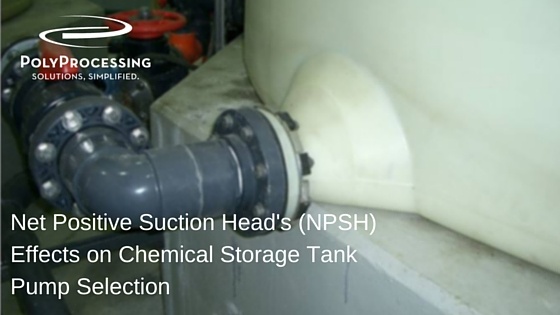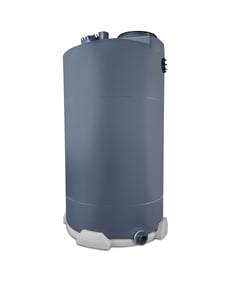Net Positive Suction Head's (NPSH) Effects on Chemical Storage Tank Pump Selection

The aspects of effective chemical storage tank design are often played out in real life, in a much less dangerous, yet still interesting, way.
For example, say you are sitting in a restaurant with a group of friends. The waiter brings your drinks and someone suggests, “let's suck these down and get refills.” You take a sip of yours, using the straw provided, but ponder how straws really work. If you just hovered your face over your glass and breathed in without a straw, you wouldn’t get any of your drink. So what about the straw makes the drink go upwards to your mouth?
The answer is “fluid dynamics”. You’re not really sucking your drink through the straw. There is no such thing in physics as “sucking”. When the straw sits in the glass, the pressure on the surface of your drink, even what’s on the inside of the straw, is the same. The trick is changing the pressures between the atmospheric drink surface and the inside of your mouth.
The same physics can be applied to tanks and pumps. Net Positive Suction Head, or NPSH, is calculated by adding the static lift, static height, and friction loss of the fluid. Let’s relate these terms back to the drink:
- Static head - the height of the liquid or drink in your “glass”
- Static lift - the height the drink will rise to -your mouth in this example
- Friction loss - a bend in the straw, or any impediment to the flow of your “drink”
Now if that drink and straw and mouth were instead a tank and pump inlet - you’re on your way to understanding NPSH. In an industrial pumping situation, it is important to know the NPSH needed for the pump system to function correctly. Let’s look at each piece of the equation.
Static Head
 Static head is the height of the fluid inside the tank before it goes into the pump. Sort of like the level of fluid in your glass before you drink any through the straw. But more specifically the bottom measurement is where it goes into the centerline of the pump. So an IMFO tank, since it sits flush with tank bottom, actually gives you additional inches of suction head over a tank with the typical pump feed fitting elevated from the bottom. You can manipulate the static lift slightly by choosing a certain tank size and height. If you place your chemical in a tall tank rather than a short tank, you will have more static head. If you use an IMFO you will have more static lift. This is useful information to the pump engineer. The amount of static head is considered in their pump sizing as NPSH is critical to pump performance.
Static head is the height of the fluid inside the tank before it goes into the pump. Sort of like the level of fluid in your glass before you drink any through the straw. But more specifically the bottom measurement is where it goes into the centerline of the pump. So an IMFO tank, since it sits flush with tank bottom, actually gives you additional inches of suction head over a tank with the typical pump feed fitting elevated from the bottom. You can manipulate the static lift slightly by choosing a certain tank size and height. If you place your chemical in a tall tank rather than a short tank, you will have more static head. If you use an IMFO you will have more static lift. This is useful information to the pump engineer. The amount of static head is considered in their pump sizing as NPSH is critical to pump performance.
Static Lift
Static lift, also called suction lift, is the vertical distance between tank outlet to pump inlet. In other words, it is the height of the fluid in the straw once it hits your mouth. This distance is positive if the pump inlet is below the tank outlet, and negative if the pump inlet is above the tank outlet. It has nothing to do with how long the straw or piping run is- It is all about the changes in elevation. (because these are actually different atmospheric pressures)
Friction Loss
Friction loss, also called head loss, is caused by turns or bends in the pump line (or “straw”) that could impact the NPSH equation. Some chemical storage facilities require pumps with pipes that have turns or bends to get the liquid from one place to the other. Of course, shorter pipe systems with more bends and turns will yield a more significant friction loss than a longer pipe system with no bends or turns. The length of run is drag or friction loss and turns or elbows are calculated as “equivalent additional lengths of drag” for making it easy to add up a total friction loss along with pipe run.
What About Tank Level? - Taking Advantage of These Pressures
Now that you understand NPSH, you can actually apply this to different tank level choices as well. It’s important to make sure that your pump is correct for tank liquid levels and your pump expert can certainly assist you with this. Determining the static head can be done with ultrasonic levels, a device that takes a soundwave and bounces it down and back to get a reading of the liquid level in a tank. On the other hand, a pressure transducer can achieve this with measurements of pressure pushing down as we described above. Pressure transducers are installed at the bottom of the tank, while ultrasonic levels are used from the top. An advantage of a device installed at the bottom is that it is not necessary to get on top of the tank for maintenance or calibration. That means less safety risk because you are working at the ground level. Another advantage is that the pressure transducer can be installed on a molded in-outlet (IMFO), which means no weld lines or seams. That helps preserve the integrity of the tank.
So, the next time someone asks why you sucked that drink down so fast, you can condescendingly tell them, “well- actually I DIDN’T- I actually created a negative pressure area with my cheeks which resulted in the Earth’s atmosphere actually pushing the drink in my glass into my mouth.”
Find out more about net positive suction head by contacting a chemical storage tank expert today.
- April 20, 2016
- Topics: Fittings and Accessories, Value Added
About Poly Processing
Posts By Topic
Tech Talk Podcast Episodes
Subscribe By Email
Recent Posts
- Installation Tips for Chemical Storage Tanks: Site Preparation and Offloading
- Understanding pH and Chemical Concentration When Choosing a Chemical Tank
- Maximizing Fill Efficiency: Selecting the Optimal Fill Line System
- Chemical Storage Tanks: A Quick Guide for End Users
- Popular Customization Options for Chemical Storage Tanks
Tank Configurator

Find the recommended tank and system components for your chemical storage challenge.
Configure a Tank Package


